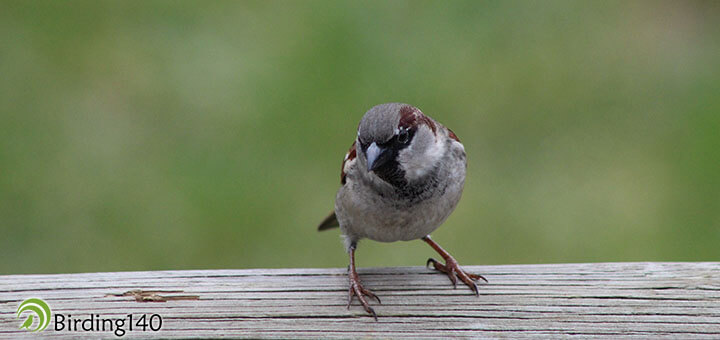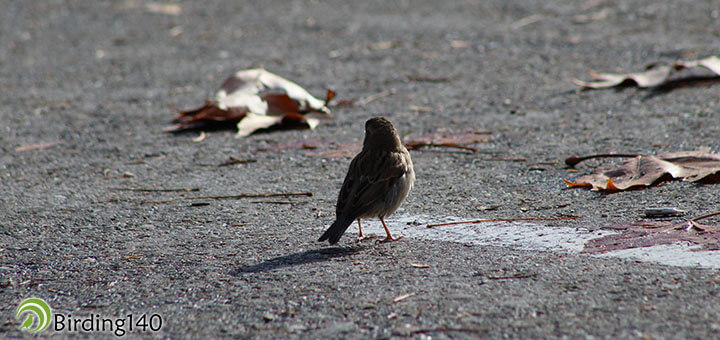The small flock of sparrows arrives to the tables of the café terrace like pirates of the air looking for easy food. They move in graceful jumps between the legs of chairs and tables, avoiding the footsteps of the clients and the tyres of the cars on the road. Their messy breast feathers seem to cover their legs as they move about. The crumbs from the human breakfast are a free buffet with a taste of toast, muffins, biscuits and a lot of sugar, which is enjoyed by these air bandits.
The organised group effectively combs the sky looking for food. Their squad-shaped organisation allows them to find the crumbs in a most effective way and to successfully carry out dispersion manoeuvres before the attack of a predator.
Some of them, emboldened by hunger, break the protocol and climb to the tables in order to steal a piece of toast before the astonished humans. These exhibitionists know that a couple of loud shrieks can provide them with a few extra crumbs from another table who wants to enjoy their presence.
CHARACTERISTICS OF THE HOUSE SPARROW
If we look at the group, the males show a rich plumage full of contrasts, especially on their head. During the winter, they wear a reddish-brown strip behind their eye and a really dark bib. The females are not so colourful though. If we observe these birds between August and September, it would be harder to distinguish the young males from the females.
We can confuse the House Sparrow with the Eurasian Tree Sparrow, although the latter has a black spot on the cheek which differentiates it, and with the Spanish Sparrow, whose abdomen is filled with black stripes.
A couple of screams from the most veteran male alert the group. Danger is near, and swiftly flapping in a straight line flight, the flock disappears from the café terrace and gets into the park across the road. This is where, after the feast, the noisy group will take a bath in the poodle of a broken fountain, disinfecting themselves with dust baths and drying in the sun.
ORIGIN AND HISTORY OF THE HOUSE SPARROW
The House Sparrow is the most distributed bird in the world. This small bird is original from the Caucasus and the Nile area. Initially granivorous and later omnivorous, this bird species has been accompanying humans for centuries. They have been among us no less than 10 000 years.
Along history, they have been praised, reviled and chased at times. It has been a common bird since humans started to live in society in prehistoric times. The Egyptian civilisation used to draw them to represent the amatorious arts. They can have intercourse as frequently as over 200 times a day. The Romans used to worship them as house protecting birds, because they ate the insects that appeared in the pantry. In China, Mao Zedong, with the Great Leap Forward project, decreed that Common Sparrows be annihilated around 1958, because they allegedly ruined the reserves of grain storages. In Japan they have been the fair representative of loyalty until today.
SCIENTIFIC NAME OF THE HOUSE SPARROW
Its scientific name, Passer domesticus, clearly references its closeness to humans. Also in French, moineau domestique, it is distinguished by its link to humans; in Spain it is called pardal, in allusion to its colours. Its size of about 15 cm is currently a reference when cataloguing other birds of similar sizes in ornithology guides.
Their great adaptive capacity has enabled them to live in all kinds of environments, from the desert to high mountain areas. Despite being the most distributed passerine in the world, nowadays the House Sparrow is in decline, especially in Europe. They live all around Europe, although they are quite scarce in Iceland. In Italy and Crete we can find the subspecies Passer domesticus italiae. In order to differentiate them, we should look at their crown and their cheeks, which are browner.
It is not so easy anymore to say that it is the most frequent urban bird. However, it is still a regular occupant of isolated buildings in the countryside, like sheds, stockyards and dovecotes. In rural areas in Spain, France and Portugal it is still possible to see communal roosts outside the breeding season (from September to December), amongst the riverside vegetation.
During the mating season, sex hormones transform the male. Its brown beak turns into a deep jet black colour, and the black bib covers its chest almost completely. That is when we can see a female surrounded by several males, which go around her with their tails open in a fan shape. The winner is carried away by the female, which pecks him in the flank.
Although it is a monogamous species, the couples formed group together in breeding colonies, which clearly favours polygamy. They frequently hybridise with the Eurasian Tree Sparrow.
THE NEST OF THE HOUSE SPARROW
The colony comprises 10 to 15 couples. In the colony, first-time specimens build their own spherical nest between April and August, while the older ones reuse their nests from previous years. Sometimes they use Common House Martin or Sand Martin nests, taking advantage of the privacy and security they provide. There are also cases where the colony settles in the base of White Stork nests, in orifices and eaves, or between the weeds or vines on the walls.
They can raise two or three layings between April and July, and between three and seven white eggs with brown spots can be found in an untidy nest lined with feathers. In those nests we can find human hair, plastics, straws and even sheep wool, depending on the resources found in the nesting area. In nests placed in hospital areas, we can even find remnants of cotton and used bandages, with the consequent health hazards it implies.
It is unknown why House Sparrow nests have a larger volume in the cities than in rural areas. In their pursuit to hide from the dangers, they even nest in heaters or exhaust stacks. In Madrid, hundreds of carcasses were found in an equestrian statue of Philip IV when it was relocated. Apparently, they entered a hole in the mouth of the horse in order to nest and died because they could not find the exit.
THE DIET OF THE HOUSE SPARROW
For the development of the little sparrows, adults need to provide them with insects, which can give us one of the keys of their decline. The fungicides and pesticides used in parks and gardens destroy this protein reserve. As a fun fact, we will say that specially in Spain, the tradition of throwing rice over the newlyweds as they leave the church is exploited by these opportunists, turning this cereal in the basis of their diet during the month of May. But they also eat privet and mulberry fruits, as well as all kinds of seeds. After two weeks, the youngsters abandon the nest.
PREDATORS OF THE HOUSE SPARROW
Amongst its predators we can spot diurnal raptors species like Montagu’s Harrier, Sparrowhawk, Eurasian Hobby, Peregrine Falcon and Booted Eagle. Amongst the nocturnal predators are the Barn Owl and the Long-eared Owl. In the cities, street cats are also a danger for House Sparrows.
DECLINE OF THE HOUSE SPARROW
The decline of the House Sparrow, especially in urban areas, seems to be related to the lack of food due to a greater cleanliness of the cities and to the closed dumpsters, as well as the decrease of cavities and eaves suitable for breeding. Moreover, we need to count the losses caused by predation and interspecific competition with larger species in order to get food.
They are also affected by the decrease in green zones caused by pollution and by the use of pesticides in gardens. According to a research carried out in Valladolid (Spain), the increase of electromagnetic fields significantly reduces its results. In addition, the repopulation with exotic vegetable species also has a negative effect, since their seeds are not suitable for the sparrows’ diet.
In Spain, during winter time they are concentrated in large cities like Madrid, Barcelona, Valencia and Seville, looking for shelter from the cold and finding many more difficulties to survive than a few years ago. It is obvious that they need our presence and they get used to it. In a recent study about the flight distance in relation to human population density, the results were surprising. They registered shorter flight distances in places with large human densities, although we don’t find anymore those groups of hundreds of specimens that used to feed on weeds and cereal seeds from the fields of the outskirts. The trips made during winter from the feeding points to the roosts do not exceed 10 km. An interesting study would be to observe whether the movements of the flocks follow a specific migratory pattern or are random.
In Brussels, the House Sparrow has almost completely disappeared. In Edinburgh, Ghent, Glasgow and Hamburg it is in the verge of extinction. Its populations have alarmingly decreased in Germany, Slovakia and Czech Republic during the last years. It is included in the Red List of birds in the UK. Its decrease in London from 1994 to 2002 stands at 60%, according to the RSPB (Royal Society for the Protection of Birds). In France, its population has suffered a decline of 20%; in Germany, of over 50%, reaching a 60% in the Netherlands, Italy and Czech Republic. In Spain, the decrease almost reaches an 11% in the last ten years, according to the data provided by SEO/BirdLife, despite their recent colonisation of the Canary Islands as a stowaway in some ship.
We can help these birds in their decline providing them with food in feeders of terraces and gardens, or in the park clearings. Let’s not forget that they like nest boxes, especially the ones that are frontally open. In addition, during the breeding season we can provide them with pieces of cotton to cover their nests. It is also quite gratifying to sit on a bench in a square with a piece of stale bread and look at the sparrows devouring it.
I fondly recall when I was young and I was lucky enough to have a specimen of this passerine bird in the window of my room for a few weeks in the winter. The eave and the window itself provided the House Sparrow with an improvised shelter during those cold days. When I lifted the blinds in the morning and I saw it flying away, I could feel the effort of the small bird to survive. After a few days, it just left.
Let’s hope that scenes like this or the one described at the beginning of the document will be seen all around Europe in the future. Let’s not miss the opportunity of making our pavement isles a bit wilder. Let’s not allow that twittering disappear in the street furniture, leaving a void which may be stating that this is not the proper rhythm of life. Let’s bear in mind that the gardens and streets on our cities and villages would be a lot poorer without these small troublemakers. Let’s do everything possible to save the sparrows.














